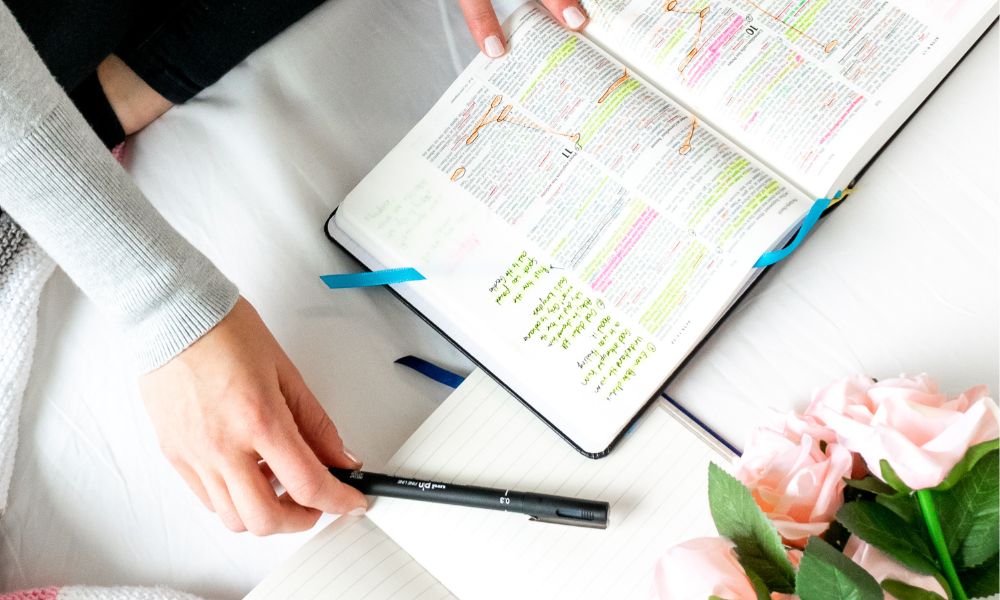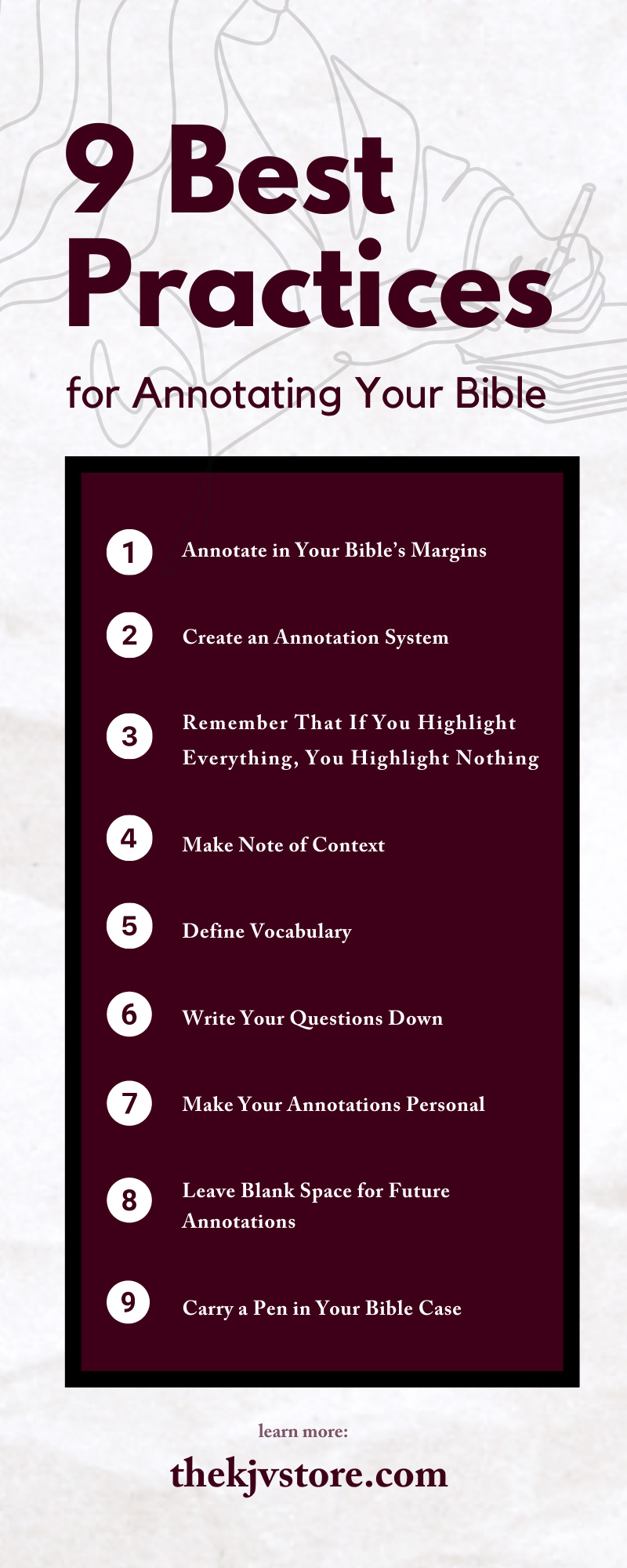9 Best Practices for Annotating Your Bible

Some people grew up scribbling notes in books, including religious books like the Bible. Others never dared to put a pen or highlighter to any book page, especially a religious one. While you should do what helps you read best, annotations are a popular way to get the most out of your reading experience. Humans remember things better when we write them down, and highlighting them can make it easier for us to find important sections later.
If you want to start annotating your Bible but don’t know how to start, that’s okay. We can help! The nine best practices below can help you create a productive annotation process.
Annotate in Your Bible’s Margins
The first place to start with annotation is deciding where you’ll make them in your Bible. Most people annotate in the margins and other blank spaces. Annotating directly in your Bible makes it easier for you to locate notes in the future. You also can’t forget your notes if they’re already in your Bible, which is helpful for classes, church, and other situations.
However, it’s okay if you’re hesitant to mark in your Bible. You can use a separate notebook if you want to create an annotation system that accommodates separate notes.
Create an Annotation System
While you can write any notes you want in your Bible’s margins or your notebook, it’s best to create an annotation system. An annotation system will keep all your notes organized, making them easy to sort through. Design your system according to your preferences so you understand every color, symbol, and mark.
Many annotation systems start with a color code. For example, you may use a red pen to write your notes about Jesus since red letter Bibles put his words in red. You may use a blue highlighter to highlight important moments involving God, such as the burning bush since many Biblical scholars and spiritual practitioners associate blue with heaven.
Your system can end with colors, or you can expand it to include symbols. For example, you could draw a triangle next to passages that focus on the Trinity since triangles have three sides. You could draw a circle next to passages that focus on resurrection since circles never end.
Lastly, you can mark your Bible in other ways. You can underline important words or voices. Some people frame important sections, drawing a box around them instead of underlining everything. The choice is yours.
Remember That If You Highlight Everything, You Highlight Nothing
No matter what annotation system you create, it’s important not to overuse it. Eventually, nothing will stick out if you highlight or otherwise annotate everything. The more you read your Bible, the more you’ll want to annotate sections but try to keep a good balance between markings and blank spaces.
Make Note of Context
Now that you know how to annotate, you need to know what to annotate. These notes are for you, so you can annotate anything you want. However, most people start their annotations with context. The Bible doesn’t exist in a vacuum, and it never has. Many verses benefit from context about the culture during the time the events occurred or about the writer. Research context about an entire book or about specific chapters within a book and write annotations based on what you find. Then, the next time you open your Bible, those notes are ready to provide context for your reading.
Define Vocabulary
Many also include vocabulary definitions in their annotations. They may define the word in the language of the Bible they’re reading, or they may find the definition of the word from its original language. The original languages of the Bible were often Hebrew for the Old Testament and Greek for the New Testament. While the King James Version is very accurate in English and the Reina Valera is very accurate in Spanish, the original language and definitions can shed helpful light on many Biblical passages.
Write Your Questions Down
You should interact with your Bible, whether you’re reading it for academic purposes or to grow your religious faith. Ask questions and hunt for answers within the Bible and from other sources. If you’re worried about forgetting your questions, write them down as annotations. Just remember to leave blank spaces so you can also write down the answers.
Make Your Annotations Personal
As we mentioned above, all these annotations are for you. Even if you share your Bible with family members or friends, these are your annotations. You don’t have to write down context, vocabulary, or questions if you don’t want to. You can annotate with prayers, quotes from teachers or pastors, or any other information that will help you read the Bible more effectively.
Leave Blank Space for Future Annotations
With all these annotation options, your Bible’s margins can fill up quickly. Try to leave blank spaces for future annotations. Many return to the same passage multiple times while owning the same Bible. You may learn something, have a follow-up question, or feel the need to record a specific prayer upon your return. You’ll want to have the space to do that.
Someday, though, you will fill up your Bible. At that point, you’ll either need to buy a new one or start annotating in a separate notebook.
Carry a Pen in Your Bible Case
Remember to carry a pen in your Bible case, whether you’re Bible is old and full of notes or new and ready for fresh ones. You never know when you may want to write something down during a sermon, a personal read at the park, or during a religious studies class. A pen must travel with you if your Bible or notebook is also going with you.
Try to also bring your highlighters and colorful pens along if your annotation system includes these tools. Many Bible cases have space for multiple writing utensils. Bring a pen in a neutral color, such as black, if you don’t have one of these cases or don’t feel like bringing everything along. You can always highlight it in the appropriate color later.
These nine best practices for annotating your Bible will help you learn and remember more every time you read. Our Scofield Bibles come with various features that can also help you learn, such as wide margins for annotations and footnotes that provide context. Consider buying a Scofield Bible today.

